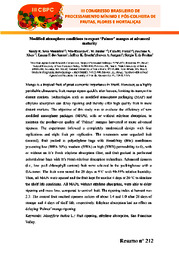Modified atmosphere conditions to export ‘Palmer’ mangos at advanced maturity.
Modified atmosphere conditions to export ‘Palmer’ mangos at advanced maturity.
Autoria: MONTEIRO, S. R. S.; MELLO JÚNIOR, N. R. C. de; FUKUI, C. M.; SANTOS, L. F. dos; BRECHT, J. F.; SARGENT, S. A.; FREITAS, S. T. de
Resumo: Mango is a tropical fruit of great economic importance in Brazil. However, as a highly perishable climacteric fruit, mango ripens quickly after harvest, limiting its transport to distant markets. Technologies such as modified atmosphere packaging (MAP) and ethylene absorption can delay ripening and thereby offer high quality fruit in more distant markets. The objective of this study was to evaluate the efficiency of new modified atmosphere packages (MAPs), with or without ethylene absorption, to maintain the postharvest quality of ‘Palmer’ mangos harvested at more advanced ripeness. The experiment followed a completely randomized design with four replications and eight fruit per replication. The treatments were unpacked fruit (control), fruit packed in polyethylene bags with BreathWay (BW) membranes presenting low (BWA 50%), medium (BWA) or high (BWB) permeability to O2, with or without an It’s Fresh ethylene absorption filter, and fruit packed in perforated polyethylene bags with It’s Fresh ethylene absorption technology. Advanced ripeness (i.e., low peel chlorophyll content) fruit were selected in the packinghouse with a DA-meter. The fruit were stored for 28 days at 9°C with 90-95% relative humidity. Then, all MAPs were opened and the fruit kept for another 4 days at 20 °C to simulate the shelf life conditions. All MAPs, without ethylene absorption, were able to delay ripening and mass loss, compared to control fruit. The ripening index at harvest was 2.3. The control fruit reached ripeness indices of about 1.4 and 1.0 after 28 days of storage and 4 days of shelf life, respectively. Ethylene absorption had no effect on delaying ‘Palmer´ mango ripening.
Ano de publicação: 2024
Tipo de publicação: Resumo em anais e proceedings
Unidade: Embrapa Semiárido
Observações
1 - Por padrão são exibidas publicações dos últimos 20 anos. Para encontrar publicações mais antigas, configure o filtro ano de publicação, colocando o ano a partir do qual você deseja encontrar publicações. O filtro está na coluna da esquerda na busca acima.
2 - Para ler algumas publicações da Embrapa (apenas as que estão em formato ePub), é necessário ter, no celular ou computador, um desses softwares gratuitos. Sistemas Android: Google Play Livros; IOS: iBooks; Windows e Linux: software Calibre.
Acesse outras publicações
Acesse a Base de Dados da Pesquisa Agropecuária (BDPA) para consultar o acervo completo das bibliotecas da Embrapa.

